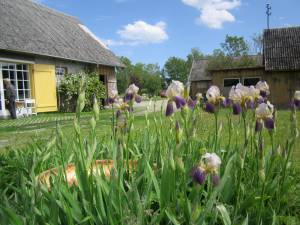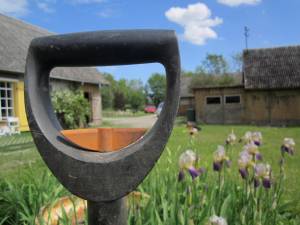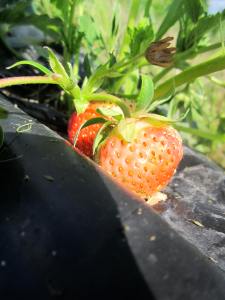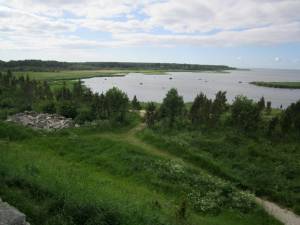You cannot fully appreciate how small a carrot seed is until you’ve individually placed 7,000 of them in furrows.
In a minor variation from wwoofing (world wide opportunities on organic farms), I had signed myself up to help on a small-scale agriculture project through helpX, a site which links you up with any schemes internationally, farming and otherwise. Most still appear to be farm-based but there are some for decorating, hostels, homestays and the like. Variety is the spice. Hosts agree to shelter and feed you in exchange for hard labour. There are only five registered in Estonia and I was accepted by my mystery hosts at a place on the large island of Saaremaa off the coast to the West. I had no idea what to expect.
Home for nearly two weeks, as it turned out, has been the small farm of Koplimae and the extended family that it accommodates. I arrived one Saturday afternoon to find a baffling profusion of people and entered into the ongoing, endless game of dishwasher Jenga that such clans naturally entail.
The genealogy steadily materialised out of the gloom. My hosts were Marju (pronounced Mario) and Olev, together with their children Johannes, Artur and Maarja (who, to go off on a tangent, is being taught basic economics at school, an innovation on the teachers’ part and clever one at that). Olev’s father – ‘Vanaisa’ or Grandpa – lives with the family. The children’s cousins on Mum’s side – Jonas and Emma – are resident for their customary summer holiday stay. On the day I arrived, both grandmothers were visiting ahead of Maarja’s 9th birthday along with a variety of neighbours, friends and passersby. A steady and plentiful steam of food was constantly emerging from the kitchen.
It was just like home.
Except for the fact that conversations around the dinner table occurred almost exclusively in Estonian. That took a bit of getting used to as it’s hard to contribute when the only words you know are ‘lick the bowl’, ‘bon appetite’, ‘curd’, ‘stone’, ‘good night’, ‘grandpa’ and ‘thanks’.
Mum is part of the local choral society. Estonians as a general rule seem to love singing, clinging to their folk songs tightly in the struggle against Russian repression. Every few years there is a song festival held in Tallinn which last time saw 35,000 singers perform at once and 110,000 people cheer them on.

The farmhouse

Sunset beyond the garden

Greenhouse with flourishing tomato plants

Maarja’s birthday. Twelve excitable young ladies plus lots of sugar.
As they produce a lot of their food themselves or buy it from other farms on the island, there is pleasingly little waste. I think the eight of them produce in one week what four of us back at home produce in a day, and we’re fairly ardent recyclers. Just goes to show how much packaging is in landfills.
My tasks have been varied. One day I was defender of the strawberries, which Pa Larkin showed I’m terrible at when he came in with a handful of bird-pecked fruit. Another I weeded the wild flowerbeds, rescued the irises from a nettle invasion, harvested chamomile flowers and planted white clover, a clever trick that the farmers play to keep the nasty weeds at bay. In fact, it turns out that I’m way more of an ignorant townie than I realised. People have chuckled at my stupid questions that only urbanites would ask: ‘You have to peel rhubarb?’ ‘If you don’t cut a pig’s balls off the meat tastes bad?’ ‘How do you tell when potatoes are ready to harvest?’
Of course, all that they’ve had to teach me so when not badgering them for something to do, I clean. I clean and clean and clean. It’s the only way I can feel useful without needing to be asked.

Diggin’

Strawberries. Hurry up and ripen!
Here at Koplimae Farm the focus is on grains – nominally spelt, rye and wheat – as well as kitchen-garden fruit and veg. The strawberries are award-winning when transformed into Marju’s delicious jam. Some of the produce is organic but they’re not religious about it which was a relief. There is nothing worse than an eco-zealot. Ok, a vegan eco-zealot, but nothing worse than that.
As a result the orders that keep the [home-made] bread and butter on the table are largely for home-milled flour, semolina, flakes and the cookies that Marju conjures from them. The two are very active in the island’s organic farming community and recently managed to secure EU funding through the Leader programme to help them with 60% of the cost of redeveloping their old barn into a swanky new cafeteria for hosting tourists and events. The official opening party is this week and you haven’t lived til you’ve tasted one of her cream gateaux or nettle quiches.

Cookies, packed and ready to go
I’ve learnt a lot. For example, at the peak of my flour packaging abilities, I could estimate to the nearest 18g when 500g of flour were in a bag. I know how many baking trays it takes to cook 20kilos of biscuits. I can tell a wild rose from a cultured rose. I know which nettles you can bake and which you can stew as tea.
As a nation, the Estonians are very creative and they tell me that this too comes from the Soviet occupation and dumb-silly collectivization policies. It being only 25 years ago, life under the Russians remains in living memory for even the middle-aged generation. There is even a resurgence of interest in Russian brands as people recall the products from their childhood. Back in those days, all the choicest cuts of meat, best vegetables and finest textiles – any produce – were mandatorily sent to Moscow, never to be seen again. Olev told me that he didn’t think he had tasted banana until after liberation. Marju said an old joke asked whether pigs were slaughtered with dynamite since all that was left to Estonian shops were the heads and trotters.
Necessity, as they say, is the mother of invention. The Russians might not have done the Estonians many favours, but in a ‘what did the Romans do for us’ Monty Python sense, they have wrought an enviable advantage of creativity. I’ve yet to meet a person on the island who can’t knit, do woodwork, make jam, cook, grow vegetables, sew, make music and fix the electrics. Everyone is very accomplished and I am envious.
The island itself is beautiful. There is a meteor lake, oak forests, beaches, windmills pretty countryside, quiet villages and a network of cottage industry farms and handicraft centres that you can visit. I have to question whether a cliff is a legitimate tourist attraction but there is some good information on things to see and do here.
On one day off that I had I met up with Dominik, a fellow couchsurfer who had climbed (read – coaxed me up) the rocks at Stolby with me in Siberia. We met in the island’s main town of Kuresaare, a pretty little town with formidable castle and picturesque streets. The island has been a strategic fighting point for many nations over the years, including the Russians, Germans, Danes, Swedes and Finns. As a result, there are many old castles and strongholds to explore, some in great working order.
We accidentally went on a 70km tour that the tourist office calls the battlefields route. I shamefully didn’t take much of the history in, but the views were cracking.

Knobbing around

Windmill, now restaurant

Waterfront

View from the stronghold near Orissaare

Kuressaare castle

Complete with portcullis